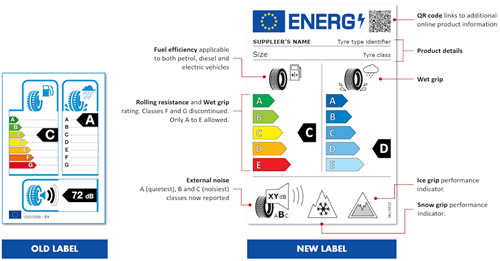All passenger tyres sold must be labelled with an official tyre label. This label contains information about three important criteria that form the basis for evaluating tyre performance: wet grip, fuel efficiency and exterior noise.
The label is a good indicator of basic tyre performance.

Rolling Resistance / Fuel Efficiency
5 classes from E (least efficient) to A (most efficient).
Effect may vary among vehicles and driving conditions, but the difference between a E and an A class for a complete set of tyres could reduce fuel consumption by up to 7.5%* when measured according to the test methods set out in Regulation EC 1222/2009
Wet Grip
5 classes from E (longest braking distance) to A (shortest braking distances).
Effect may vary among vehicles and driving conditions, but in the case of full braking, the difference between a E and an A class for the set of four identical tyres could be up to 30% shorter braking distance (e.g for a typical passenger car driving at 80 kmh speed this could be up to 18m shorter braking distance)* when measured according to the test methods set out in Regulation EC 1222/2009
Noise Rating
In addition to the noise value in decibel dB(A), the lower the noise the better.
A pictogram displays whether the tyre external rolling noise performance is above the future European mandatory limit value (3 black bars = noisier tyre), between the future limit value and 3 dB below (2 black bars = average tyre) or more than 3 dB below the future limit value (1 black bar = low noise tyre). NB: The tyre external rolling noise is not entirely correlated to vehicle interior noise.